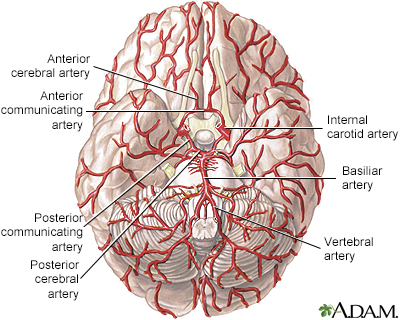Pregnancy SmartSiteTM
Vertebrobasilar insufficiency; Posterior circulation ischemia; Beauty parlor syndrome; TIA - vertebrobasilar insufficiency; Dizziness - vertebrobasilar insufficiency; Vertigo - vertebrobasilar insufficiency DefinitionVertebrobasilar circulatory disorders are conditions in which the blood supply to the back of the brain is disrupted. CausesIn the neck, two vertebral arteries join to form the basilar artery, which enters the skull. These are the main blood vessels that provide blood flow to the back of the brain. The areas in the back of the brain that receive blood from these arteries are needed to keep a person alive. These areas regulate breathing, heart rate, swallowing, vision, movement, and posture or balance. All of the nervous system signals that connect the brain to the rest of the body pass through the back of the brain. Many different conditions may reduce or stop blood flow in the back part of the brain. The most common risk factors are smoking, high blood pressure, diabetes, increased age, and a high cholesterol level. These are similar to the risk factors for any stroke. Other causes include:
SymptomsCommon symptoms may include:
Other symptoms may include:
Exams and TestsYou may have the following tests, depending on the cause:
TreatmentVertebral or basilar symptoms that start suddenly are a medical emergency that need to be treated right away. Treatment is similar to that for stroke. Depending on how long you have had symptoms among others, a medicine may be infused to break open any blood clots. A catheter may be inserted into a blood vessel to remove a clot. Some people receive both treatments. To prevent the condition, your health care provider may recommend:
Invasive procedures or surgery of narrowed arteries for stroke prevention in this part of the brain are not well studied or proven. Outlook (Prognosis)The outlook depends on:
Each person has a different recovery time and need for long-term care. Problems with moving, thinking, and talking often improve in the first weeks or months. Some people will keep improving for months or years. Possible ComplicationsComplications of vertebrobasilar circulatory disorders are the same as for a stroke. These include:
Complications caused by medicines or surgery may also occur. When to Contact a Medical ProfessionalCall 911 or the local emergency number, or get to the emergency room if you have any symptoms of a vertebral or basilar circulatory disorder. ReferencesCrane BT, Kaylie DM. Central vestibular disorders. In: Flint PW, Francis HW, Haughey BH, et al, eds. Cummings Otolaryngology: Head and Neck Surgery. 7th ed. Philadelphia, PA: Elsevier; 2021:chap 168. Jovin TG, Li C, Wu L, et al. Trial of thrombectomy 6 to 24 Hours after stroke due to basilar-artery occlusion. N Engl J Med. 2022;387(15):1373-1384. PMID: 36239645 pubmed.ncbi.nlm.nih.gov/36239645/. Kleindorfer DO, Towfighi A, Chaturvedi S, et al. 2021 Guideline for the prevention of stroke in patients with stroke and transient ischemic attack: a guideline from the American Heart Association/American Stroke Association. Stroke. 2021;52(7):e364-e467. PMID: 34024117 pubmed.ncbi.nlm.nih.gov/34024117/. Kim JS, Caplan LR. Vertebrobasilar disease. In: Grotta JC, Albers GW, Broderick JP, et al, eds. Stroke: Pathophysiology, Diagnosis, and Management. 7th ed. Philadelphia, PA: Elsevier; 2022:chap 26. | ||
| ||
Review Date: 8/19/2024 Reviewed By: Joseph V. Campellone, MD, Department of Neurology, Cooper Medical School at Rowan University, Camden, NJ. Review provided by VeriMed Healthcare Network. Also reviewed by David C. Dugdale, MD, Medical Director, Brenda Conaway, Editorial Director, and the A.D.A.M. Editorial team. View References The information provided herein should not be used during any medical emergency or for the diagnosis or treatment of any medical condition. A licensed medical professional should be consulted for diagnosis and treatment of any and all medical conditions. Links to other sites are provided for information only -- they do not constitute endorsements of those other sites. No warranty of any kind, either expressed or implied, is made as to the accuracy, reliability, timeliness, or correctness of any translations made by a third-party service of the information provided herein into any other language. © 1997- A.D.A.M., a business unit of Ebix, Inc. Any duplication or distribution of the information contained herein is strictly prohibited. | ||


 Arteries of the br...
Arteries of the br...
